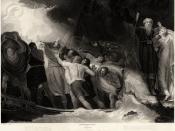"The journey not the arrival matters."The above statement: "the journey not the arrival matters," holds very little credibility. This can be seen by the examination of 3 texts, all of different medium that portray similar, yet differently expressed ideas about the imaginative journey. The play: The Tempest (1623), by William Shakespeare will be shown to argue that the ultimate result for the real world is the most important issue, yet cannot be arrived at without the presence of an imaginative journey. The picture book Where the Wild Things Are by author Maurice Sendak will be shown to explore the ultimate effects for the real world, and hence the destination as the most important aspect, however again, the imaginative journey is essential to the ultimate arrival of the journey in the text. The final assertion of the importance of the arrival can be seen in Coleridge's Poem This Lime Tree Bower My prison where a message will be clearly learned as a result of the imaginative journey, hence affirming the importance of the journey's arrival.
All the texts have catalysts, journey processes and results, most often in the form of learning, and since these journeys cause a change in their protagonists when they return from their imaginative journey, it accentuates the importance of both the journey and subsequently, the arrival. Each text from different periods in time will support the 'contradictory statement' that "the journey and the arrival matter"The Tempest is a Renaissance play that explores the artificial construct of an island as a place of magic and imagination, yet despite the centrality of imagination to the play, its ultimate concern is for the effects of in the arrival in the real world. This can be seen with the harpy banquet scene, whereby the phantasm of the harpies as an illusionary...


